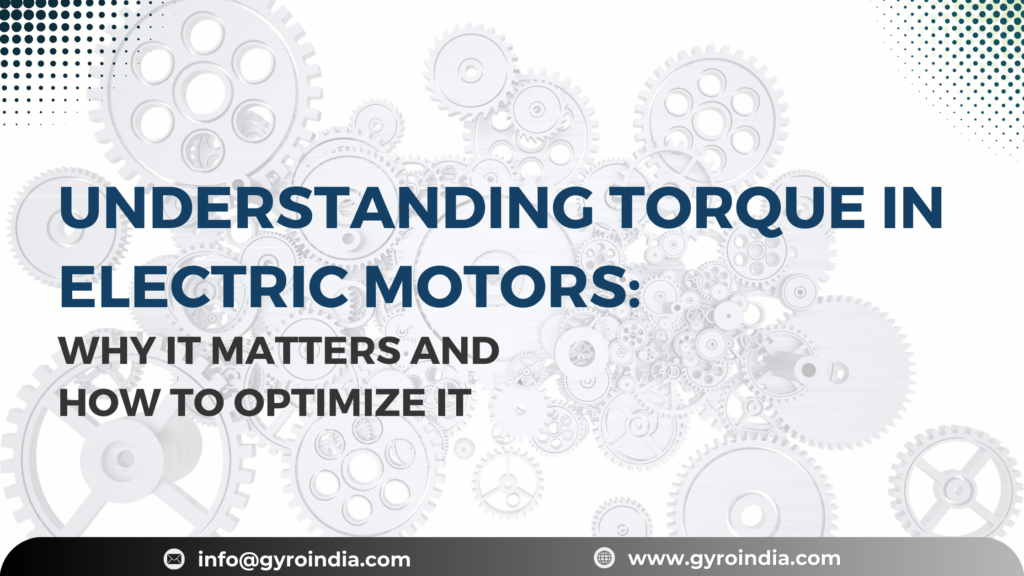Understanding Torque in Electric Motors: Why It Matters and How to Optimize It
Akash Gaddamwar2024-10-01T06:19:53+00:00 Electric motors are everywhere—powering everything from household appliances to industrial machinery and electric vehicles. But have you ever wondered what makes these motors tick? The answer often lies in a key concept: torque. Understanding torque in electric motors is crucial because it’s what determines how well a motor performs its job. So, let’s dive into what it really is, why it matters, and how you can optimize it for your applications.
Electric motors are everywhere—powering everything from household appliances to industrial machinery and electric vehicles. But have you ever wondered what makes these motors tick? The answer often lies in a key concept: torque. Understanding torque in electric motors is crucial because it’s what determines how well a motor performs its job. So, let’s dive into what it really is, why it matters, and how you can optimize it for your applications.
What is Torque and Why Does It Matter?
At its core, It is a measure of the rotational force that an electric motor generates. Think of it like the “twist” that gets wheels moving or a mixer churning. It is essentially the motor’s muscle—its ability to get things moving and keep them in motion. Without sufficient torque, even the most advanced motor could struggle to perform its intended task, especially under load. For example, in electric vehicles, high torque at low speeds is what gives you that instant acceleration when you hit the pedal.
Understanding it is crucial because it directly affects an electric motor’s efficiency, speed, and overall performance. The right amount of it ensures that your motor can handle the demands of its application without overheating or wearing out prematurely. If a motor doesn’t produce enough torque, it could stall, underperform, or consume more energy than necessary, leading to inefficiency and higher operational costs. On the other hand, too much it can cause mechanical stress or damage components. Balancing it is, therefore, essential for optimal motor performance.
Types of Torque: Starting, Running, and Peak
Torque isn’t a one-size-fits-all concept; it comes in different types depending on the motor’s operation stage. The three primary types are starting torque, running torque, and peak torque.
Starting torque, also known as breakaway torque, is the amount of force needed to start the motor from a standstill. It’s the initial push that gets things moving. Motors with high starting it is ideal for applications like elevators or heavy machinery, where overcoming inertia is key.
Running it, on the other hand, is the force the motor generates while in continuous operation. This is what keeps the motor moving once it’s already in motion. Consistent running it is critical for applications where steady performance is necessary, such as conveyor belts or fans.
Lastly, peak torque is the maximum amount of the motor can produce under optimal conditions. It’s important to note that operating at peak it for extended periods can lead to overheating or motor damage. Understanding these is types helps in selecting the right motor for specific tasks, ensuring efficiency and longevity.
How to Optimize Torque for Better Performance
Optimizing it isn’t just about choosing a powerful motor; it’s about matching the motor’s capabilities to your specific needs. One way to optimize it is through proper motor sizing. Oversizing a motor might seem like a good idea, but it can lead to wasted energy and increased costs. Conversely, an undersized motor might struggle to meet the requirements, leading to poor performance or even failure. Conducting a thorough load analysis can help you determine the appropriate it needed for your application.
Another effective method for optimizing it is through variable frequency drives (VFDs). VFDs allow for better control of motor speed and torque, adapting to the changing demands of the application. For instance, in HVAC systems, VFDs can adjust motor speed to match airflow requirements, resulting in energy savings and reduced wear.
Proper maintenance also plays a crucial role in torque optimization. Regular checks on motor components such as bearings, gears, and windings can prevent torque-related issues. Lubrication, alignment, and timely repairs can help maintain optimal torque levels, ensuring the motor runs efficiently and extends its lifespan.
The Impact of Torque on Energy Efficiency
Optimizing it not only boosts performance but also enhances energy efficiency. Motors that operate at optimal torque levels consume less energy, reduce operational costs, and have a lower environmental impact. By understanding and managing it, businesses can achieve significant savings while also contributing to sustainability goals.
Choosing the right motor with the appropriate it specifications for your application is a key step towards energy efficiency. For industries focusing on green initiatives, this can be a game-changer. By using motors that are finely tuned for their tasks, you not only save on electricity bills but also reduce your carbon footprint.
Conclusion
Understanding what torque is and how it impacts electric motors is fundamental for anyone working with these machines. It is more than just a force—it’s the driving power behind the performance and efficiency of your motors. By optimizing it, you can ensure that your motors are not just running but running well, delivering the power and efficiency needed for your applications. Whether you’re dealing with industrial machinery, electric vehicles, or home appliances, getting torque right is the key to unlocking your motor’s full potential.
Click here to know more

Leave a Reply